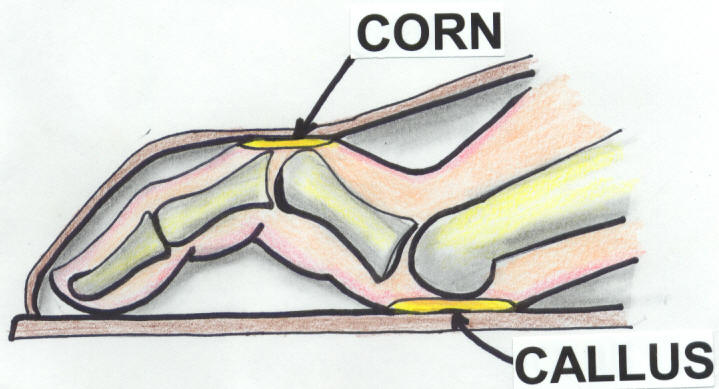Corns And Calluses Causes, Symptoms, Diagnosis and Treatment

What Are Corns And Calluses?
Corns and calluses are thick, specially shaped hardened layer of dead skin which usually occurs on thin or hairless and smooth skin surfaces, mainly the dorsal surface of toes and fingers.
It is developed due to the attempt of the skin to protect itself from pressure or friction. If there is constant stimulation of the tissue producing the corns, even after the corn is surgically removed, the skin may continue to grow as a corn.
Corns and calluses may be a source of embarrassment for the affected individual since they are unsightly to look at. Treatment may be sought if they cause discomfort.
Corns can be further divided into hard and soft corn. The location of the soft corns tends to differ from that of hard corns. Hard corns occur on dry, flat surfaces of skin. Soft corns (frequently found between adjacent toes) stay moist, keeping the surrounding skin soft.
Causes Of Corn And Calluses:
Biologically, calluses are formed by the accumulation of terminally undifferentiated keratinocytes in the outermost layer of skin.
Repetitive pressure and long exposure to friction leads to the development of corns and calluses.
Sources of pressure may include:
- Wearing ill-fitting shoes.
- Improper waling motion
- Not wearing socks
- Playing instruments or using hand tools.
- Certain activities, such as:
construction work
wood carving,
use of a chef’s knife
Trikke carving
rock climbing
Hiking
martial arts
weight training
BMXing
Dancing (especially ballet)
Chopping wood
Wearing high heels.
Sometimes a callus occurs where there is no rubbing or pressure. These hyperkeratoses can have a variety of causes.
- Toxic materials, such as arsenic, can cause thick palms and soles.
- Diseases, such as syphilis, can cause thickening of the palms and soles as well as pinpoint hyperkeratoses.
- Condition called keratosis palmaris et plantaris, which produces corns in the creases of the fingers and non-weight bearing spaces of the feet.
Certain factors increase the risk of developing corns and calluses. They include:
- Bunions.
- Hammertoe.
- Bone spurs
Symptoms Of Corns And Calluses:
Symptoms and signs of corns and calluses include
- a thick, hard patch of skin;
- bump on the skin;
- area of flaky, dry skin;
- Pain or tenderness of the affected area.
Diagnosis Of Corns And Calluses:
Corns and calluses can be diagnosed via:
- A physical exam, to rule out other causes of thickened skin, such as warts and cysts.
- An X-ray, to detect any physical abnormality which may be causing the corn or callus.
Treatment Of Corns And Calluses:
Relieving pressure from the affected are usually helps in treating corns and calluses.
Other treatment measures may include:
- Trimming away excess skin.
- Callus-removing medication.
- Medication to reduce infection risk.
- Shoe inserts, in case of underlying foot deformity
- Surgery
By : Natural Health News




